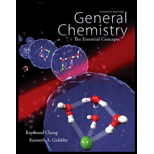
Concept explainers
Interpretation: The spontaneity of an
Concept Introduction:
Standard EMF:
The electromotive force (EMF) is the maximum potential difference between two electrodes of a galvanic cell.
This quantity is related to the tendency for an element.
i.e.- It has a great tendency to acquire or gain the compound.
Spontaneous reaction: A reaction is said to be spontaneous, if it occurs without being driven by some external force.
There are two type of driving force
1) Enthalpy
2) Entropy
A reducing agent is the chemical species that under goes a
We can say it one compound in an oxidation – reduction (redox) reaction.
The reducing agent is losing electron and it said to be oxidized.
Equilibrium:
It can be defined as the state of a chemical reaction in which its forward and reverse reaction occurs at equal rates so that the concentration of the reactant and products does not change with time.
It’s also known as dynamic equilibrium.
A state which opposing forces or influences are balanced.
This is a state of physical balance.
To discuss: The spontaneity of an electrochemical reaction in term of its standard emf (
Want to see the full answer?
Check out a sample textbook solution
Chapter 19 Solutions
Package: General Chemistry with Connect 2-year Access Card
 ChemistryChemistryISBN:9781305957404Author:Steven S. Zumdahl, Susan A. Zumdahl, Donald J. DeCostePublisher:Cengage Learning
ChemistryChemistryISBN:9781305957404Author:Steven S. Zumdahl, Susan A. Zumdahl, Donald J. DeCostePublisher:Cengage Learning ChemistryChemistryISBN:9781259911156Author:Raymond Chang Dr., Jason Overby ProfessorPublisher:McGraw-Hill Education
ChemistryChemistryISBN:9781259911156Author:Raymond Chang Dr., Jason Overby ProfessorPublisher:McGraw-Hill Education Principles of Instrumental AnalysisChemistryISBN:9781305577213Author:Douglas A. Skoog, F. James Holler, Stanley R. CrouchPublisher:Cengage Learning
Principles of Instrumental AnalysisChemistryISBN:9781305577213Author:Douglas A. Skoog, F. James Holler, Stanley R. CrouchPublisher:Cengage Learning Organic ChemistryChemistryISBN:9780078021558Author:Janice Gorzynski Smith Dr.Publisher:McGraw-Hill Education
Organic ChemistryChemistryISBN:9780078021558Author:Janice Gorzynski Smith Dr.Publisher:McGraw-Hill Education Chemistry: Principles and ReactionsChemistryISBN:9781305079373Author:William L. Masterton, Cecile N. HurleyPublisher:Cengage Learning
Chemistry: Principles and ReactionsChemistryISBN:9781305079373Author:William L. Masterton, Cecile N. HurleyPublisher:Cengage Learning Elementary Principles of Chemical Processes, Bind...ChemistryISBN:9781118431221Author:Richard M. Felder, Ronald W. Rousseau, Lisa G. BullardPublisher:WILEY
Elementary Principles of Chemical Processes, Bind...ChemistryISBN:9781118431221Author:Richard M. Felder, Ronald W. Rousseau, Lisa G. BullardPublisher:WILEY





